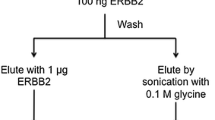Abstract
To develop a targeting vector for breast cancer biotherapy, MDA-MB-231 cell, a human breast cancer cell line, was co-cultured with pC89 (9 aa) phage display library of random peptides. In multiple independent peptide-presenting phage screening trials, subtilisin was used as a protease to inactivate extra-cellular phages. The internalized phages were collected by cell lysising and amplified in E. coli XLI-Blue. Through five rounds of selection, the peptide-presenting phages which could be internalized in MDA-MB-231 cells were isolated. A comparison was made between internalization capacities of peptide-presenting phages isolated from MDA-MB-231 cells and RGD-integrin binding phage by coculturing them with other human tumor cell lines and normal cells. The nucleotide sequences of isolated peptide-presenting phages were then determined by DNA sequencing. To uncover whether phage coat protein or amino acid order was required for the character of the peptide to MDA-MB-231 cells, three peptides were synthesized. They are CASPSGALRSC, ASPSGALRS and CGVIFDHSVPC (the shifted sequence of CASPSGALRSC), and after coculturing them with different cell lines, their targeting capacities to MDA-MB-231 cells were detected. These data suggested that the internalization process was highly selective, and capable of capturing a specific peptide from parent peptide variants. Moreover, the targeting internalization event of peptides was an amino acid sequence dependent manner. The results demonstrated the feasibility of using phage display library of random peptides to develop new targeting system for intracellular delivery of macromolecules, and the peptide we obtained might be modified as a targeting vector for breast cancer gene therapy.
Similar content being viewed by others
References
Miller N, Vile R G. Targeted vectors for gene therapy. FASEB J, 1995, 9: 190
Miller C R, Buchsbaum D J, Reynolds P N, et al. Differential susceptibility of primary and established human glioma cells to adenovirus infection: Targeting via the epidermail growth factor receptor achieves fiber receptor-independent gene transfer. Cancer Res, 1998, 58: 5738–5748
Trepel M, Grifman M, Weitzman M D, et al. Molecular adaptors for vascular-targeted adenoviral gene delivery. Hum Gene Ther, 2000, 11: 1971–1981
Luciana D, Costantino V, Adriana Z, et al. Modified phage peptide libraries as a tool to study specificity of phosphorylation and recognition of tyrosine containing peptide. J Mol Biol, 1997, 269:694–703
Liu F, Guo X R, Gong H X, et al. A resistin binding peptide selected by phage display inhibits 3T3-L1 preadipocyte differentiation. Chin Med J, 2006, 119: 496–503
Sambrook J, Russell D. Molecular Cloning: A Laboratory Manual. 2nd ed. Cold Spring Harbor: Cold Spring Harbor Laboratory Press, 1998. 215–233
Green M, Loewenstein P M. Autonomous functional domains of chemically synthesized human immunodeficiency virus Tat trans-dctivator protein. Cell, 1988, 55: 1179–1188
Frankel A D, Pabo C O. Cellular uptake of Tat protein from human immunodeficiency virus. Cell, 1988, 55: 1189–1193
Xiong F, Xiao S, Peng F. Herpes simplex virus VP22 enhances adenovirus-mediated microdystrophin gene transfer to skeletal muscles in dystrophin-deficient (mdx) mice. Hum Gene Ther, 2007, 18:490–501
Schwarze S R, Hruska K A, Dowdy S F. Protein transduction: Unrestricted delivery into all cells. Cell Biol Int, 2000, 10: 290–295
Ho A, Schwarze S R, Mermelstein S J, et al. Synthetic protein transduction domains: Enhanced transduction potential in vitro and in vivo. Cancer Res, 2001, 61: 474–477
Rajotte D, Ruoslahti E. Membrane dipetidase is the receptor for a Lung-targeting peptide dentified by in vivo phage display. J Biol Chem, 1999, 274: 11593–11598
Vives E, Brodin P, Lebleu B. A truncated HIV-TAT protein basic domain rapidly translocates through the plasma membrane and accumulates in the cell nucleus. J Biol Chem, 1997, 272: 16010–16017
Elliott G, O’Hare P. Intercellular trafficking and protein delivery by a herpesvirus structural protein. Cell, 1997, 88: 223–233
Le Roux I, Joliot A H, Bloch Gallego E, et al. Neurotrophic activity of the antennapedia homeodomain depends on its specific DNA-binding properties. Pro Natl Acad Sci USA, 1993, 90: 9120–9124
Itoh K. Development of diagnostically and therapeutically useful human antibody medicines by phage display system. Yakugaku Zasshi, 2007, 127: 43–53
Erkki K, Bingcheng W, Erkki R, et al. Page libraries displaying cyclic peptides with different ring size: ligand specificities of the rgd-directed integrins. Biotechniques, 1995, 13: 265–270
Seker U O, Wilson B, Dincer S, et al. Adsorption behavior of linear and cyclic genetically engineered platinum binding peptides. Langmuir, 2007, 23(15): 7895–7900
Lark M W, Stioup G B, Hwang S M, et al. design and characterization of an orally active Arg-gly-asp peptidomimetic vitronectin receptor antagorust, SB 265123, for the prevent of bone loss in ostesporosis. J Pharmacol Exp Ther, 1999, 291: 612–617
Eguchi A, Akuta T, Okugama H, et al. Protein transduction domain of HIV-Tat protein promotes efficient delivey of DNA into mammalian cells. J Biol Chem, 2001, 276: 26204–26210
Del G, Moore V, Payne R M. Transactiviator of transcription fusion protein transduction causes membrane in version. J Biol Chem, 2004, 179(31): 32541–32544
Author information
Authors and Affiliations
Corresponding author
Additional information
Supported by the National Natural Science Foundation of China (Grant No. 30460142)
About this article
Cite this article
Dong, J., Liu, W., Jiang, A. et al. A novel peptide, selected from phage display library of random peptides, can efficiently target into human breast cancer cell. Chin. Sci. Bull. 53, 860–867 (2008). https://doi.org/10.1007/s11434-008-0162-3
Received:
Accepted:
Published:
Issue Date:
DOI: https://doi.org/10.1007/s11434-008-0162-3




